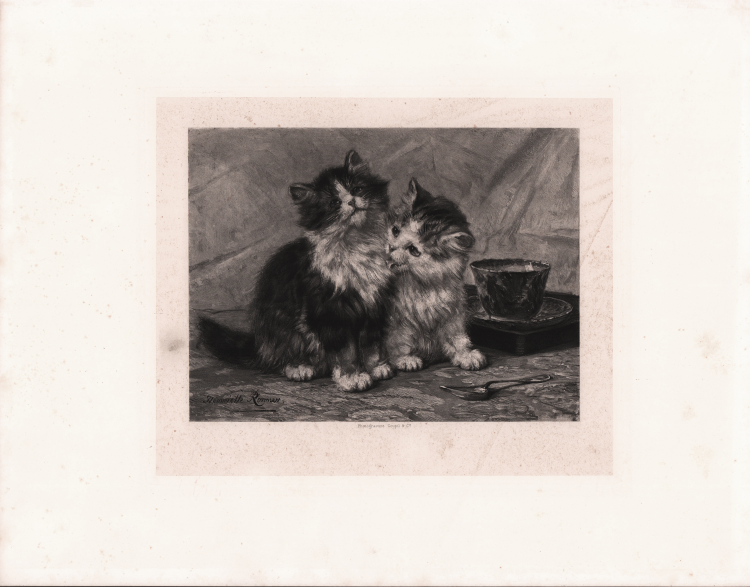



| Reference: | S6923 |
| Author | Adolphe GOUPIL |
| Year: | 1891 |
| Measures: | 240 x 200 mm |


| Reference: | S6923 |
| Author | Adolphe GOUPIL |
| Year: | 1891 |
| Measures: | 240 x 200 mm |
Photogravure, circa 1891, signed at the center.
After a painting by Henriette Ronner (Amsterdam 1821-1909).
Proof before title on china wove paper, with full margins, perfect condition.
This work is part of the exhibition catalogue of Henriette Ronner, published by Goupil Gallery.
Exhibition catalogue extract: 'Cats and kittens by Madame Henriette Ronner, May 189 ... Goupil Gallery' Catalogue includes advertisement for 'Henriette Ronner, The Painter of Cat-Life and Cat-Character' with text by M.H. Spielmann, containing a portrait and twelve full-page illustrations in photogravure by Boussod, Valadon & Co.
|
Goupil & Cie was a leading art dealership in 19th-century France, with headquarters in Paris. Step by step, Goupil established a worldwide trade in fine art reproductions of paintings and sculptures, with a network of branches in London, Brussels, The Hague, Berlin and Vienna, as well as in New York and Australia. Instrumental for this expansion were the Ateliers Photographiques, a plant north of Paris, in Asnières, which took up work in 1869. The leading figure was Adolphe Goupil (1806–1893). His daughter Marie married the French artist Jean-Léon Gérôme.
After several partnerships from 1827 onwards, Adolphe Goupil formed Goupil & Cie in 1850. Over the next 34 years the partners were Adolphe Goupil 1850–84, Alfred Mainguet 1850–56, Léon Goupil 1854–55, Léon Boussod 1856–84, Vincent van Gogh 1861–72, Albert Goupil 1872–84, René Valadon 1878–84. Until 1861 the firm concentrated on buying, selling and editing prints. To feed an emerging middle-class market for inexpensive art, Goupil's factory outside Paris employed skilled craftsmen to produce engraved, etched, photographic and even sculptural copies of paintings in vast quantities. Goupil's reproductions made Jean-Léon Gérôme, in particular, a well known artist.[1] When Vincent van Gogh (art dealer) (1820–1888),[2] the uncle of painter Vincent van Gogh (who was known as Uncle Cent by Vincent and his brother Theo), entered the firm, the business was expanded to paintings and drawings, finally in 1872 to industrial images, including photographic and héliographic procedures.
Vincent van Gogh fell ill and retired in 1872, but left his money in the firm until 1878. His duties were taken over by Albert Goupil, son of Adolphe. When, in 1878, the van Gogh shares were finally withdrawn, René Valadon entered the business. From then on the firm was completely in the hands of the Goupil family and their sons-in-law Léon Boussod and René Valadon. In 1884 the Goupil family retired and the firm was again transformed and renamed Boussod, Valadon & Cie, successeurs de Goupil & Cie. Three years later, 25–27 May 1887, the stock of the gallery was sold at auction, "caused by the renewal of the ancient firm Goupil & Cie".
|
|
Goupil & Cie was a leading art dealership in 19th-century France, with headquarters in Paris. Step by step, Goupil established a worldwide trade in fine art reproductions of paintings and sculptures, with a network of branches in London, Brussels, The Hague, Berlin and Vienna, as well as in New York and Australia. Instrumental for this expansion were the Ateliers Photographiques, a plant north of Paris, in Asnières, which took up work in 1869. The leading figure was Adolphe Goupil (1806–1893). His daughter Marie married the French artist Jean-Léon Gérôme.
After several partnerships from 1827 onwards, Adolphe Goupil formed Goupil & Cie in 1850. Over the next 34 years the partners were Adolphe Goupil 1850–84, Alfred Mainguet 1850–56, Léon Goupil 1854–55, Léon Boussod 1856–84, Vincent van Gogh 1861–72, Albert Goupil 1872–84, René Valadon 1878–84. Until 1861 the firm concentrated on buying, selling and editing prints. To feed an emerging middle-class market for inexpensive art, Goupil's factory outside Paris employed skilled craftsmen to produce engraved, etched, photographic and even sculptural copies of paintings in vast quantities. Goupil's reproductions made Jean-Léon Gérôme, in particular, a well known artist.[1] When Vincent van Gogh (art dealer) (1820–1888),[2] the uncle of painter Vincent van Gogh (who was known as Uncle Cent by Vincent and his brother Theo), entered the firm, the business was expanded to paintings and drawings, finally in 1872 to industrial images, including photographic and héliographic procedures.
Vincent van Gogh fell ill and retired in 1872, but left his money in the firm until 1878. His duties were taken over by Albert Goupil, son of Adolphe. When, in 1878, the van Gogh shares were finally withdrawn, René Valadon entered the business. From then on the firm was completely in the hands of the Goupil family and their sons-in-law Léon Boussod and René Valadon. In 1884 the Goupil family retired and the firm was again transformed and renamed Boussod, Valadon & Cie, successeurs de Goupil & Cie. Three years later, 25–27 May 1887, the stock of the gallery was sold at auction, "caused by the renewal of the ancient firm Goupil & Cie".
|